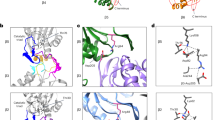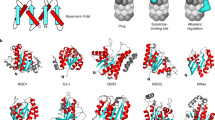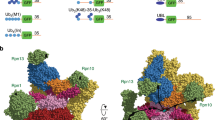Abstract
The proteasome controls the turnover of many cellular proteins. Two structural features are typically required for proteins to be degraded: covalently attached ubiquitin polypeptides that allow binding to the proteasome and an unstructured region in the targeted protein that initiates proteolysis. Here, we have tested the degradation of model proteins to further explore how the proteasome selects its substrates. Using purified yeast proteasome and mammalian proteasome in cell lysate, we have demonstrated that the two structural features can act in trans when separated onto different proteins in a multisubunit complex. In such complexes, the location of the unstructured initiation site and its chemical properties determine which subunit is degraded. Thus, our findings reveal the molecular basis of subunit specificity in the degradation of protein complexes. In addition, our data provide a plausible explanation for how adaptor proteins can bind to otherwise stable proteins and target them for degradation.
This is a preview of subscription content, access via your institution
Access options
Subscribe to this journal
Receive 12 print issues and online access
$259.00 per year
only $21.58 per issue
Buy this article
- Purchase on Springer Link
- Instant access to full article PDF
Prices may be subject to local taxes which are calculated during checkout






Similar content being viewed by others
Accession codes
References
Glickman, M.H. & Ciechanover, A. The ubiquitin-proteasome proteolytic pathway: destruction for the sake of construction. Physiol. Rev. 82, 373–428 (2002).
Hochstrasser, M. Lingering mysteries of ubiquitin-chain assembly. Cell 124, 27–34 (2006).
Deveraux, Q., Ustrell, V., Pickart, C. & Rechsteiner, M. A 26 S protease subunit that binds ubiquitin conjugates. J. Biol. Chem. 269, 7059–7061 (1994).
Lam, Y.A., Lawson, T.G., Velayutham, M., Zweier, J.L. & Pickart, C.M. A proteasomal ATPase subunit recognizes the polyubiquitin degradation signal. Nature 416, 763–767 (2002).
Lee, C., Schwartz, M.P., Prakash, S., Iwakura, M. & Matouschek, A. ATP-dependent proteases degrade their substrates by processively unraveling them from the degradation signal. Mol. Cell 7, 627–637 (2001).
Johnson, E.S., Gonda, D.K. & Varshavsky, A. Cis-trans recognition and subunit-specific degradation of short-lived proteins. Nature 346, 287–291 (1990).
Hochstrasser, M. & Varshavsky, A. In vivo degradation of a transcriptional regulator: the yeast alpha 2 repressor. Cell 61, 697–708 (1990).
Nishiyama, A. et al. A nonproteolytic function of the proteasome is required for the dissociation of Cdc2 and cyclin B at the end of M phase. Genes Dev. 14, 2344–2357 (2000).
Verma, R., McDonald, H., Yates, J.R. & Deshaies, R.J. Selective degradation of ubiquitinated Sic1 by purified 26S proteasome yields active S phase cyclin-Cdk. Mol. Cell 8, 439–448 (2001).
Elsasser, S. et al. Proteasome subunit Rpn1 binds ubiquitin-like protein domains. Nat. Cell Biol. 4, 725–730 (2002).
Goebl, M.G., Goetsch, L. & Byers, B. The Ubc3 (Cdc34) ubiquitin-conjugating enzyme is ubiquitinated and phosphorylated in vivo. Mol. Cell. Biol. 14, 3022–3029 (1994).
Heessen, S., Masucci, M.G. & Dantuma, N.P. The Uba2 domain functions as an intrinsic stabilization signal that protects Rad23 from proteasomal degradation. Mol. Cell 18, 225–235 (2005).
Schauber, C. et al. Rad23 links DNA repair to the ubiquitin/proteasome pathway. Nature 391, 715–718 (1998).
Prakash, S., Tian, L., Ratliff, K.S., Lehotzky, R.E. & Matouschek, A. An unstructured initiation site is required for efficient proteasome-mediated degradation. Nat. Struct. Mol. Biol. 11, 830–837 (2004).
Hartley, R.W. Directed mutagenesis and barnase-barstar recognition. Biochemistry 32, 5978–5984 (1993).
Schreiber, G. & Fersht, A.R. Interaction of barnase with its polypeptide inhibitor barstar studied by protein engineering. Biochemistry 32, 5145–5150 (1993).
Bachmair, A., Finley, D. & Varshavsky, A. In vivo half-life of a protein is a function of its amino-terminal residue. Science 234, 179–186 (1986).
Bachmair, A. & Varshavsky, A. The degradation signal in a short-lived protein. Cell 56, 1019–1032 (1989).
Gonda, D.K. et al. Universality and structure of the N-end rule. J. Biol. Chem. 264, 16700–16712 (1989).
Ciechanover, A. & Ben-Saadon, R. N-terminal ubiquitination: more protein substrates join in. Trends Cell Biol. 14, 103–106 (2004).
Stack, J.H., Whitney, M., Rodems, S.M. & Pollok, B.A. A ubiquitin-based tagging system for controlled modulation of protein stability. Nat. Biotechnol. 18, 1298–1302 (2000).
Thrower, J.S., Hoffman, L., Rechsteiner, M. & Pickart, C.M. Recognition of the polyubiquitin proteolytic signal. EMBO J. 19, 94–102 (2000).
Beal, R.E., Toscano-Cantaffa, D., Young, P., Rechsteiner, M. & Pickart, C.M. The hydrophobic effect contributes to polyubiquitin chain recognition. Biochemistry 37, 2925–2934 (1998).
Johnston, J.A., Johnson, E.S., Waller, P.R. & Varshavsky, A. Methotrexate inhibits proteolysis of dihydrofolate reductase by the N-end rule pathway. J. Biol. Chem. 270, 8172–8178 (1995).
Tian, L., Holmgren, R.A. & Matouschek, A. A conserved processing mechanism regulates the activity of transcription factors cubitus interruptus and NF-κB. Nat. Struct. Mol. Biol. 12, 1045–1053 (2005).
Gonzalez, S.L., Stremlau, M., He, X., Basile, J.R. & Münger, K. Degradation of the retinoblastoma tumor suppressor by the human papillomavirus type 16 E7 oncoprotein is important for functional inactivation and is separable from proteasomal degradation of E7. J. Virol. 75, 7583–7591 (2001).
Berezutskaya, E. & Bagchi, S. The human papillomavirus E7 oncoprotein functionally interacts with the S4 subunit of the 26S proteasome. J. Biol. Chem. 272, 30135–30140 (1997).
Whitby, F.G. & Hill, C.P. A versatile platform for inactivation and destruction. Structure 15, 137–138 (2007).
Dang, Y., Siew, L.M. & Zheng, Y.H. APOBEC3g is degraded by the proteasomal pathway in a Vif-dependent manner without being polyubiquitylated. J. Biol. Chem. 283, 13124–13131 (2008).
Chen, L. & Madura, K. Rad23 promotes the targeting of proteolytic substrates to the proteasome. Mol. Cell. Biol. 22, 4902–4913 (2002).
Elsasser, S. & Finley, D. Delivery of ubiquitinated substrates to protein-unfolding machines. Nat. Cell Biol. 7, 742–749 (2005).
McClellan, A.J., Tam, S., Kaganovich, D. & Frydman, J. Protein quality control: chaperones culling corrupt conformations. Nat. Cell Biol. 7, 736–741 (2005).
Xie, Y. & Varshavsky, A. Physical association of ubiquitin ligases and the 26S proteasome. Proc. Natl. Acad. Sci. USA 97, 2497–2502 (2000).
Verma, R., Oania, R., Graumann, J. & Deshaies, R.J. Multiubiquitin chain receptors define a layer of substrate selectivity in the ubiquitin-proteasome system. Cell 118, 99–110 (2004).
Jeffrey, P.D. et al. Mechanism of Cdk activation revealed by the structure of a Cyclin A-Cdk2 complex. Nature 376, 313–320 (1995).
King, R.W., Glotzer, M. & Kirschner, M.W. Mutagenic analysis of the destruction signal of mitotic cyclins and structural characterization of ubiquitinated intermediates. Mol. Biol. Cell 7, 1343–1357 (1996).
Klotzbücher, A., Stewart, E., Harrison, D. & Hunt, T. The 'destruction box' of cyclin A allows B-type cyclins to be ubiquitinated, but not efficiently destroyed. EMBO J. 15, 3053–3064 (1996).
Verhoef, L.G. et al. Minimal length requirement for proteasomal degradation of ubiquitin-dependent substrates. FASEB J. published online, doi:10.1096/fj.08-115055 (16 September 2008).
Zhang, M. & Coffino, P. Repeat sequence of Epstein-Barr virus-encoded nuclear antigen 1 protein interrupts proteasome substrate processing. J. Biol. Chem. 279, 8635–8641 (2004).
Bienkiewicz, E.A., Adkins, J.N. & Lumb, K.J. Functional consequences of preorganized helical structure in the intrinsically disordered cell-cycle inhibitor p27(Kip1). Biochemistry 41, 752–759 (2002).
Lee, C., Prakash, S. & Matouschek, A. Concurrent translocation of multiple polypeptide chains through the proteasomal degradation channel. J. Biol. Chem. 277, 34760–34765 (2002).
Sharon, M. et al. 20S proteasomes have the potential to keep substrates in store for continual degradation. J. Biol. Chem. 281, 9569–9575 (2006).
Stankunas, K. & Crabtree, G.R. Exploiting protein destruction for constructive use. Proc. Natl. Acad. Sci. USA 104, 11511–11512 (2007).
Banaszynski, L.A., Chen, L.C., Maynard-Smith, L.A., Ooi, A.G. & Wandless, T.J. A rapid, reversible, and tunable method to regulate protein function in living cells using synthetic small molecules. Cell 126, 995–1004 (2006).
Stankunas, K. et al. Conditional protein alleles using knockin mice and a chemical inducer of dimerization. Mol. Cell 12, 1615–1624 (2003).
Pratt, M.R., Schwartz, E.C. & Muir, T.W. Small-molecule-mediated rescue of protein function by an inducible proteolytic shunt. Proc. Natl. Acad. Sci. USA 104, 11209–11214 (2007).
Matsuzawa, S., Cuddy, M., Fukushima, T. & Reed, J.C. Method for targeting protein destruction by using a ubiquitin-independent, proteasome-mediated degradation pathway. Proc. Natl. Acad. Sci. USA 102, 14982–14987 (2005).
Janse, D.M., Crosas, B., Finley, D. & Church, G.M. Localization to the proteasome is sufficient for degradation. J. Biol. Chem. 279, 21415–21420 (2004).
Sakamoto, K.M. et al. Protacs: chimeric molecules that target proteins to the Skp1-Cullin-F box complex for ubiquitination and degradation. Proc. Natl. Acad. Sci. USA 98, 8554–8559 (2001).
Saeki, Y., Isono, E. & Toh-E, A. Preparation of ubiquitinated substrates by the PY motif-insertion method for monitoring 26S proteasome activity. Methods Enzymol. 399, 215–227 (2005).
Acknowledgements
We thank R.W. Carthew, A.C. Rosenzweig, J. Widom and members of the Matouschek lab (Northwestern University), as well as R.J. Deshaies (Caltech), for advice and comments, and we thank G. Leigh for editing the manuscript. The work was supported by grant R01GM64003 from the US National Institutes of Health, by the Leukemia and Lymphoma Society and by the Robert H. Lurie Comprehensive Cancer Center at Northwestern University. T.I. gratefully acknowledges a Japan Society for the Promotion of Science Postdoctoral Fellowship for Research Abroad.
Author information
Authors and Affiliations
Contributions
S.P., T.I. and A.M. designed the experiments and wrote the manuscript. S.P. and T.I. performed most of the experiments. A.J.H. assisted S.P. in performing some of the degradation experiments, in purifying proteins and in constructing many of the genes.
Corresponding author
Supplementary information
Supplementary Text and Figures
Supplementary Figures 1 and 2, and Supplementary Methods (PDF 960 kb)
Rights and permissions
About this article
Cite this article
Prakash, S., Inobe, T., Hatch, A. et al. Substrate selection by the proteasome during degradation of protein complexes. Nat Chem Biol 5, 29–36 (2009). https://doi.org/10.1038/nchembio.130
Received:
Accepted:
Published:
Issue Date:
DOI: https://doi.org/10.1038/nchembio.130
This article is cited by
-
Disordered region of cereblon is required for efficient degradation by proteolysis-targeting chimera
Scientific Reports (2019)
-
Cdc48-independent proteasomal degradation coincides with a reduced need for ubiquitylation
Scientific Reports (2015)
-
Regulated protein turnover: snapshots of the proteasome in action
Nature Reviews Molecular Cell Biology (2014)
-
Host restriction factors in retroviral infection: promises in virus-host interaction
Retrovirology (2012)
-
Defining the geometry of the two-component proteasome degron
Nature Chemical Biology (2011)



